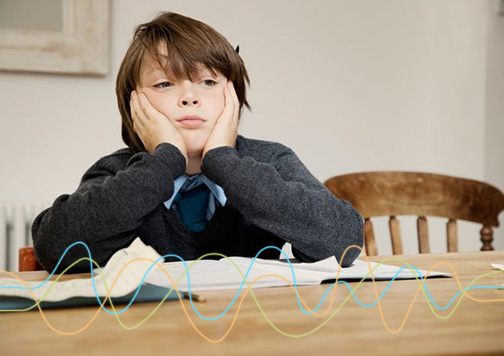Attention Deficit Hyperactivity Disorder

Can Neurofeedback Help with Attention Deficit Hyperactivity Disorder?
Neurofeedback is now being used with the most difficult children in the custody of the State of California. It is being used in a Federal penitentiary, and in the California prison system. It is being used in the Minnesota school systems and elsewhere. There are some 8,000 or more professionals providing Neurofeedback to ADHD kids around the US. Probably some 100,000 children per year are being helped. This is only a fraction of those who are on stimulant medication, but then the effect of Neurofeedback is cumulative. Next year, it will be another 100,000, and within a decade most children will no longer be on stimulants.
Attention deficit/hyperactivity disorder (ADHD) is the most commonly diagnosed behavioral disorder of childhood, estimated to affect between 3% and 5% of school-aged children. The core symptoms of ADHD include inattention, hyperactivity, and impulsivity. Although many people occasionally have difficulty sitting still, paying attention, or controlling impulsive behavior, these behaviors are so persistent in people with ADHD that they interfere with daily life. Generally, these symptoms appear before the age of 7 and cause significant functional problems at home, in school, and in various social settings. One- to two-thirds of all children with ADHD (somewhere between 1% and 6% of the general population) continue to exhibit ADHD symptoms into adult life. Diagnosis is difficult (usually requiring more than one visit) but it is essential, as early treatment can substantially alter the course of a child’s educational and social development.
Symptoms of ADHD
If you notice several symptoms of inattention or hyperactivity in an individual they might be suffering from ADD or ADHD. This diagnosis can seem scary, but be assured that there are treatments that can reduce or eliminate the symptoms. At The Think Hub Center, we can give you an accurate diagnosis and an effective treatment plan.
A person is considered to have ADHD if he or she demonstrates symptoms of inattention, hyperactivity, and impulsivity for at least 6 months, and in at least two settings (such as at home and in school). The signs and symptoms listed below are typically seen in children with ADHD and usually appear before age seven. (In order to diagnose ADHD in adults, psychiatrists must determine how the adult patient behaved as a child.)
Associated symptoms of ADHD
- failing to pay close attention to details
- making careless mistakes
- the inability to sustain attention during tasks
- not listening when spoken to
- problems following through on instructions
- failure to complete tasks
- difficulty organizing tasks
- disliking work
- losing items
- being easily distracted
- being forgetful
- Some individuals with ADD are hyperactive
- There is a component to the disorder which causes impulsive behavior.
- The symptoms of hyperactivity can include:
- fidgeting or squirming
- the inability to stay seated
- difficulty being quiet
- talking excessively
- blurting out answers
- difficulty waiting for your turn
- interrupting frequently
Treatment for ADHD
Despite the effectiveness of stimulant medications, multiple strategies are required to effectively manage ADHD over the long-term. A combination of prescription drugs and lifestyle changes, including behavioral therapies, is proving to be the best option for many children. Currently, the most accepted treatments include individual and family education, behavioral therapy, school remediation, and social skills training. Although nutritional management (such as elimination diets and high-dose vitamin supplementation) is among the most frequently explored alternative therapy among parents, relatively few studies support its effectiveness for ADHD. A growing number of studies suggest an association between essential fatty acid (EFA) deficiencies and hyperactivity in children, yet intervention studies using EFAs to treat behavioral problems have reported varying results. Preliminary evidence also indicates that homeopathy and mind/body techniques, particularly biofeedback, may significantly improve behavior among children with ADHD.
Neurofeedback and ADHD
The names and symptoms for ADHD have changed frequently since the turn of the century. What is now referred to as ADHD has been described in the past as Minimal Brain Dysfunction, Hyperkinetic Reaction of Childhood, and Attention Deficit Disorder (ADD) With or Without Hyperactivity. The name ADHD was adopted in 1987 by the third revision of the Diagnostic and Statistical Manual of Mental Disorders (DSM-III-R).
Diagnosis is largely dependent on specific, observed behaviors. The first step in establishing the diagnosis of ADHD is to determine whether the individual meets the diagnostic criteria, as defined in the DSM-IV. The DSM-IV’s symptomatic criteria were developed for children; there are no specific criteria for ADHD in adults. In these cases, physicians will often determine the psychiatric status of the adult patient as a child and make a retroactive diagnosis of childhood ADHD. Since most of the characteristic behaviors of childhood ADHD occur at home and in the school setting, parents and teachers play an important role in providing information to establish the diagnosis.
DSM-IV Diagnostic Criteria: Either (1) or (2) 1. Six (or more) symptoms of inattention that persist for at least 6 months to a mal-adaptive degree inconsistent with the child’s developmental level 2. Six (or more) symptoms of hyperactivity-impulsivity that persist for at least 6 months to a mal-adaptive degree, inconsistent with the child’s developmental level Some inattentive or hyperactive-impulsive symptoms that cause impairment are present before the age of 7 years Some impairment from symptoms present in two or more settings (such as at school/work and home). Clear evidence of significant impairment in functioning. Symptoms not secondary to another psychological disorder (such as mood disorder, anxiety disorder)
Although most children with ADHD have symptoms of both inattention and hyperactivity-impulsivity, some tend to demonstrate symptoms from one cluster or the other. These specific subtypes of ADHD are based on the predominant symptom pattern exhibited for at least 6 months. ADHD, Combined Type, if both A1 and A2 criteria are met; ADHD, Predominantly Inattentive Type, if A1 is met, but A2 is not; ADHD, Predominantly Hyperactive-Impulsive Type, if A2 is met, but A1 is not
